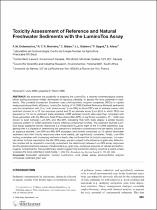 ResearchSpace
ResearchSpace
Toxicity assessment of reference and natural freshwater sediments with the luminotox assay
JavaScript is disabled for your browser. Some features of this site may not work without it.
- ResearchSpace
- →
- Research Publications/Outputs
- →
- Journal Articles
- →
- View Item
| dc.contributor.author |
Dellamatrice, PM

|
|
| dc.contributor.author |
Monteiro, RTR

|
|
| dc.contributor.author |
Blaise, C

|
|
| dc.contributor.author |
Slabbert, JL

|
|
| dc.contributor.author |
Gagne, JL

|
|
| dc.contributor.author |
Alleau, S

|
|
| dc.date.accessioned | 2007-07-03T08:31:26Z | |
| dc.date.available | 2007-07-03T08:31:26Z | |
| dc.date.issued | 2006-08 | |
| dc.identifier.citation | Dellamatrice, PM, et al. 2006. Toxicity assessment of reference and natural freshwater sediments with the luminotox assay. Environmental Toxicology (Special issue - 12th International Symposium on Toxicity Assessment, 12 papers), Vol. 21(4), pp 395-402 | en |
| dc.identifier.issn | 1520-4081 | |
| dc.identifier.uri | http://hdl.handle.net/10204/857 | |
| dc.description | Copyright: 2006 John Willey & Sons Inc | en |
| dc.description.abstract | We (the authors) examined the possibility of adapting the LuminoTox, a recently-commercialised bioanalytical testing procedure initially developed for aqueous samples, to assess the toxic potential of sediments. A significant correlation was shown to exist between LuminoTox-Solid Phase Assay (Lum-SPA) and Microtox Solid Phase Assay (Mic-SPA) indicating that both tests display a similar toxicity response pattern for CRM sediments having differing contaminant profiles. The sediment elutriate Lum-ELU assay displayed toxicity responses (i.e., measurable IC20s) for eight of the 14 CRM sediments, suggesting it is capable of determining the presence of sediment contaminants that are readily soluble in an aqueous elutriate. Lum-SPA and Mic-SPA bioassays were further conducted on 12 natural freshwater sediments and their toxicity responses were again significantly correlated. Finally, Lum-SPA testing undertaken with increasing mixtures of kaolin clay confirmed that its toxicity responses, in a manner similar to those reported for the Mic-SPA assay, are also subject to the influence of fines. While further studies will be required to more fully understand the relationship between Lum-SPA assay responses and the physicochemical makeup of sediments (e.g., grain size, combined presence of natural and anthropogenic contaminants), these preliminary results suggest that LuminoTox testing could be a useful screen to assess the toxic potential of solid media. | en |
| dc.language.iso | en | en |
| dc.publisher | John Wiley & Sons Inc | en |
| dc.subject | Water pollution | en |
| dc.subject | Sediment | en |
| dc.subject | Contamination | en |
| dc.subject | Chemical leakage | en |
| dc.subject | Toxicity tests | en |
| dc.subject | Bioassays | en |
| dc.title | Toxicity assessment of reference and natural freshwater sediments with the luminotox assay | en |
| dc.type | Article | en |
| dc.identifier.apacitation | Dellamatrice, P., Monteiro, R., Blaise, C., Slabbert, J., Gagne, J., & Alleau, S. (2006). Toxicity assessment of reference and natural freshwater sediments with the luminotox assay. http://hdl.handle.net/10204/857 | en_ZA |
| dc.identifier.chicagocitation | Dellamatrice, PM, RTR Monteiro, C Blaise, JL Slabbert, JL Gagne, and S Alleau "Toxicity assessment of reference and natural freshwater sediments with the luminotox assay." (2006) http://hdl.handle.net/10204/857 | en_ZA |
| dc.identifier.vancouvercitation | Dellamatrice P, Monteiro R, Blaise C, Slabbert J, Gagne J, Alleau S. Toxicity assessment of reference and natural freshwater sediments with the luminotox assay. 2006; http://hdl.handle.net/10204/857. | en_ZA |
| dc.identifier.ris | TY - Article AU - Dellamatrice, PM AU - Monteiro, RTR AU - Blaise, C AU - Slabbert, JL AU - Gagne, JL AU - Alleau, S AB - We (the authors) examined the possibility of adapting the LuminoTox, a recently-commercialised bioanalytical testing procedure initially developed for aqueous samples, to assess the toxic potential of sediments. A significant correlation was shown to exist between LuminoTox-Solid Phase Assay (Lum-SPA) and Microtox Solid Phase Assay (Mic-SPA) indicating that both tests display a similar toxicity response pattern for CRM sediments having differing contaminant profiles. The sediment elutriate Lum-ELU assay displayed toxicity responses (i.e., measurable IC20s) for eight of the 14 CRM sediments, suggesting it is capable of determining the presence of sediment contaminants that are readily soluble in an aqueous elutriate. Lum-SPA and Mic-SPA bioassays were further conducted on 12 natural freshwater sediments and their toxicity responses were again significantly correlated. Finally, Lum-SPA testing undertaken with increasing mixtures of kaolin clay confirmed that its toxicity responses, in a manner similar to those reported for the Mic-SPA assay, are also subject to the influence of fines. While further studies will be required to more fully understand the relationship between Lum-SPA assay responses and the physicochemical makeup of sediments (e.g., grain size, combined presence of natural and anthropogenic contaminants), these preliminary results suggest that LuminoTox testing could be a useful screen to assess the toxic potential of solid media. DA - 2006-08 DB - ResearchSpace DP - CSIR KW - Water pollution KW - Sediment KW - Contamination KW - Chemical leakage KW - Toxicity tests KW - Bioassays LK - https://researchspace.csir.co.za PY - 2006 SM - 1520-4081 T1 - Toxicity assessment of reference and natural freshwater sediments with the luminotox assay TI - Toxicity assessment of reference and natural freshwater sediments with the luminotox assay UR - http://hdl.handle.net/10204/857 ER - | en_ZA |





